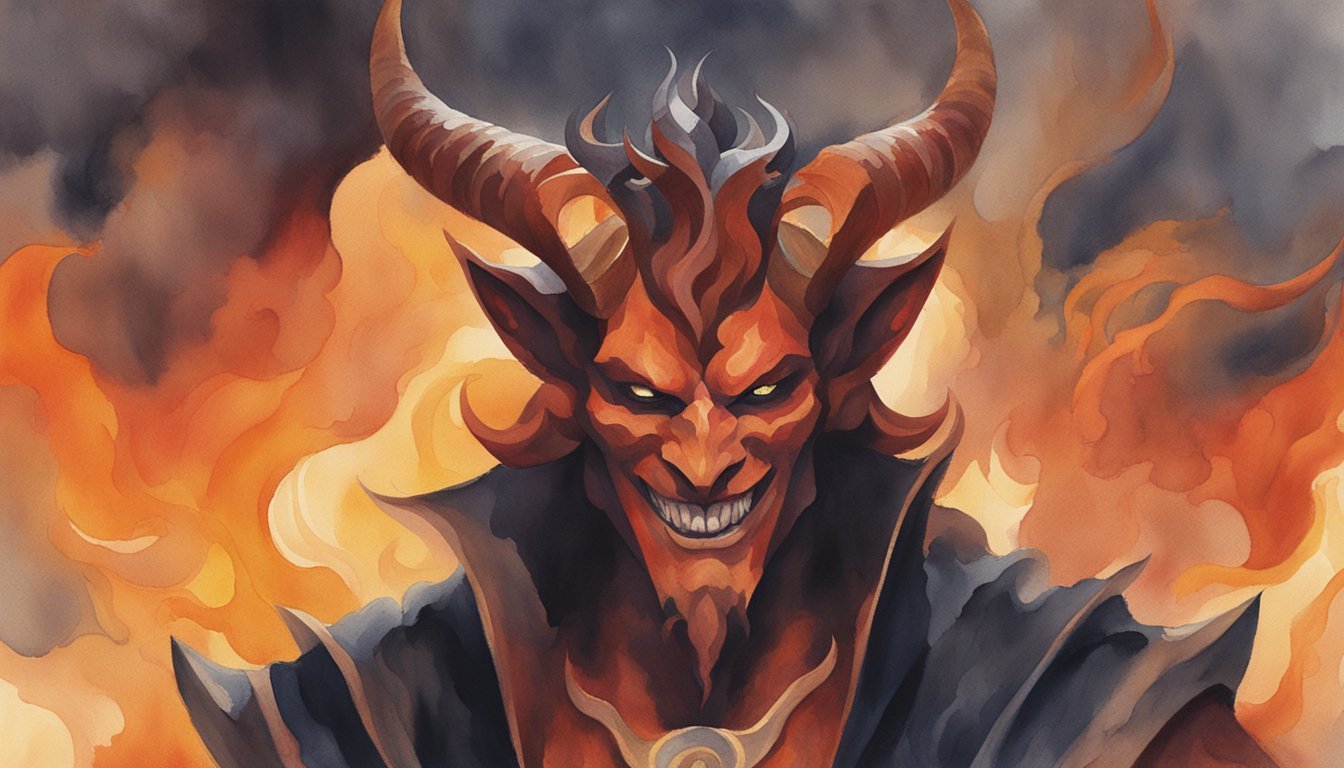Cultural and Religious Depictions of the Devil
Biblical Descriptions and Symbolism
In various scriptures across the bible, the devil is depicted in multiple forms and under different names. In the Book of Genesis, the devil appears as a serpent in the Garden of Eden, tempting Eve to taste the forbidden fruit. In the New Testament, he is Satan, the adversary of God and humanity. In the Old Testament, he is sometimes referred to as Lucifer, the fallen angel, or Beelzebub.
The title “Morning Star” appears in the Book of Isaiah, associating it with the devil’s fall from Heaven. Symbolism of the devil as a dragon can be found in scripture, particularly in the Book of Revelation. Interestingly, the cherub, a type of angel, is also mentioned in association with the devil’s fall from grace in the Old Testament. This connection has led to various interpretations throughout history, influencing religious art and literature. Understanding these representations requires knowledge of historical contexts, including BC and AD meaning, which helps scholars examine the evolution of such symbolism over time. Throughout different eras, the depiction of the devil has shifted, reflecting changing theological and cultural perspectives.
Historical Artistic Representations
Over the centuries, the devil has been represented in various ways within art. Early Christian art portrayed Satan as having animalistic features such as horns, a tail, and sometimes even hooves. In the Middle Ages, he was often depicted as a grotesque and monstrous figure, capable of striking fear into the hearts of those who beheld him.
In contrast, some artists chose to depict Satan as a more human-like figure, reflecting his cunning and seductive nature. For instance, during the Renaissance, many artists portrayed him as a beautiful and deceptive fallen angel. Nevertheless, the depiction of Satan in art can vary greatly across different periods and cultures, reflecting the ever-changing image of evil in the human imagination.
Modern Day Interpretations in Media
In contemporary media, the devil is often portrayed in various ways, from a sinister, seductive figure to an emblem of mischief. In literature and film, the devil has taken on a plethora of appearances, ranging from the cunning serpent in adaptations of the Garden of Eden story to the sophisticated, charming antagonist in modern tv shows and movies.
It is also common to find the devil making appearances in popular music and art, where the portrayal can range from the classic horned, red-skinned figure to more abstract representations of evil. The evolution of the devil’s portrayal in modern media reflects society’s changing perceptions and understanding of evil throughout history.
Across different cultures and religions, the devil has been depicted in various ways, with each interpretation reflecting a unique perspective of what embodies evil. From biblical descriptions and symbolism to historical artistic representations, and modern-day interpretations in media, the image of the devil will likely continue to captivate and intrigue humanity for generations to come.
Theological Interpretations and Beliefs

Character and Role in Religious Texts
The Devil, also known as Satan, is a complex figure in Christianity, with diverse interpretations of his character and role. According to the Bible, he was originally an angel who fell from grace and became the adversary of God and humanity. He is often described as a deceiver, who disguises himself as an angel of light to lead people astray. Satan’s role in the story of Adam and Eve in the Garden of Eden highlights his cunning nature, as he entices them to eat the forbidden fruit, ultimately introducing sin and death into the world.
Throughout the Bible, Satan is portrayed as a powerful enemy who forges plans to deceive and undermine humanity’s relationship with God. As we read in 1 Peter 5:8, he is compared to a roaring lion, prowling around, looking for someone to devour. However, he is ultimately subject to God’s authority, and his power is limited by the righteousness of the faithful.
Impact on Faith and Christian Concept of Evil
The Devil’s existence and actions have shaped the Christian concept of evil, sin, temptation, and the consequences of turning away from God. His presence in the Bible serves as a reminder to Christians to be vigilant and wary of the deceiving influences around them. The likeness to a roaring lion emphasizes the severity and danger he poses to the faithful.
Satan embodies the principle of pride, a trait that was responsible for his own fall from heaven, and it represents the root of many sins. Understanding the Devil’s character helps believers develop a better appreciation of the importance of humility and the need to rely on God’s grace for salvation. This symbolic representation of evil serves to motivate Christians in their pursuit of righteousness and to nurture their faith in God’s ultimate triumph over wickedness.
Eschatology and the End Times
The Devil also plays a significant role in Christian eschatology, particularly with regards to the apocalypse and the eventual destruction of evil. In Isaiah 14:12, the Morning Star (Satan) is described as having fallen from heaven, but the prophecy promises his ultimate defeat. There are also passages in the Bible that refer to the Antichrist, a figure closely associated with Satan, who will rise to power in the end times but will eventually be destroyed by Jesus Christ.
Satan’s eventual defeat and destruction is thus a source of hope and reassurance for believers, who long for the day when Christ will return to establish the kingdom of heaven on earth. Expected to be a time of peace and harmony, the elimination of Satan and his deceptive nature will mark the fulfillment of the divine plan and the triumph of God over the forces of evil.
In conclusion, the Devil’s role in Christianity has had significant impact on shaping the understanding of evil, sin, and temptation, as well as offering hope for a future without such negative influences. His presence throughout the Bible serves as an important figure for exploring the complexities of faith, human nature, and the divine plan.

